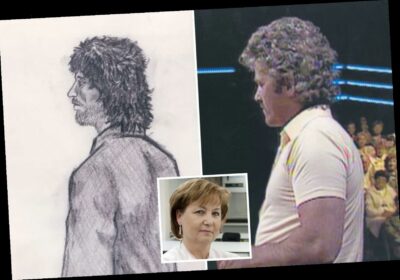The Pembrokeshire Murders: Tiny clue found in suspect's kitchen finally nailed killer after 25 years

A TOP forensic scientist has told of the moment she and her team spotted the crucial piece of evidence that stopped a murderer- 25 years after his horrific crimes.
A strand of DNA and a chance appearance on a TV show brought down Bullseye killer John Cooper, the monster behind two double killings.
More than six million Brits have been watching the story unfold on three-part ITV drama The Pembrokeshire Murders.
And now Professor Angela Gallop has told The Mirror how she helped find the "golden nugget" of evidence needed by senior investigating officer Detective Superintendent Steve Wilkins – played in the drama by Luke Evans.
Prof Gallop was called in after cops reached a dead end with their investigation of the vile killings in the 1980s.
The charred remains of siblings Richard and Helen Thomas, 58 and 54, were found in the ruins of their remote Pembrokeshire farmhouse, Scoveston Manor, in 1985.
Four years later, husband and wife Peter and Gwenda Dixon were murdered as they walked along the Pembrokeshire Coastal Path.
Their bodies were later found hidden in undergrowth.
All four victims had been shot at point-blank range and it was clear the cases were linked – although the investigations remained unsolved for more than two decades.
A cold case review was launched in 2005 – and Prof Gallop, group chief executive officer of Oxfordshire-based Forensic Access, was initially called in to trawl through DNA samples.
She and her team initially failed to find anything new.
However, she then persuaded cops to test more items seized from the two crimes scenes.
And three years later, she finally found traces of fibre on a glove – and they linked to Cooper, played in the series by Keith Allen.
Prof Gallop told the paper: “We then started looking at other items relating to Cooper, including a pair of shorts found atop of his kitchen units.
"Under a microscope and on the lower left leg of the shorts was the tiniest piece of evidence – a blood stain that matched Peter Dixon’s DNA.
"It was the golden nugget – linking him to the one of the double murders was finally discovered.”
Mr Dixon had been forced to hand over his bank card and PIN number, which was used four times to withdraw money.
A member of the public gave a description of a man wearing shorts acting suspiciously as he withdrew cash.
After the find, cops rushed to find a photo of Cooper at the time of the murders.
But they had no luck – until they discovered he had appeared on TV darts competition Bullseye in May 1989, just a month before the Dixons were killed.
An image of Cooper was then compared to an artist's impression of the wanted killer, which was sketched at the time of the original investigation.
Cooper was already serving 16 years for armed robbery and 30 burglaries when Prof Gallop found his DNA.
He was interviewed behind bars as part of the cold case review – but released on parole in 2008.
Cops knew he would soon strike again, and redoubled their efforts to get the evidence they needed to secure a conviction.
“The pressure was on them and us,” Prof Gallop said.
“We knew Cooper discarded a lot of his offending gear in hedgerows, including blue knitted acrylic gloves.
"I think he thought they could not be linked to him.
"One of the gloves was made of fibres that matched some of the fibres on branches and Peter’s belt. It had been tagged by the police as exhibit BB109.
“We went on to find BB109-type fibres on Peter’s shorts, jumper and leg tapings, along with exposed parts of Gwenda’s body and her sweatshirt.
“Then we looked under the microscope at more tapings – strips of sticky tape that can pull off anything from surfaces.
"One piece of clothing we looked at was a pair of Gwenda’s khaki shorts found in Cooper’s kitchen. Under the microscope we spotted a minute flake of blood.
“DNA profiling on that flake produced a full profile matching it to Peter. The chances of it being anyone else’s were less than one in a billion."
Further tests on the shorts were done before she told detectives.
Under a microscope they found the stain the flake had come from, again it matched Peter’s DNA.
She called Steve – and told him: “I think we’ve found your golden nugget."
Her team then found evidence linking him to Richard Thomas in the pockets of the same shorts.
They found two types of fibres, both similar to those on part of Richard’s sock, salvaged from the fire-ravaged murder scene.
Finally, they had enough to convict their killer.
Cooper, now aged 76, pleaded not guilty to the murders, but was convicted by a jury in 2011 and handed a whole-life sentence – meaning he can never be freed.
No clear motive has ever been established for the killings.
Angela, who is played by actress Anastasia Hille in the TV drama, says of Cooper: “He wasn’t as smart as he seemed to think he was – these days science is always one step ahead of the crooks I have helped bring to justice and that pleases me.
"He obviously does not know much about forensic science."
And she said she's "pleased for all the victims' families" to get answers to "what must be the most terrible thing to happen to anyone – the murder of a loved one”.
“The Cooper case gave me great satisfaction to help solve," she said.
“I have to say BB109 is one of my favourite exhibit for what it represents – that science helped the police bring an evil man to justice.
"That’s why I do and love my job – justice for all, that is important to me.”
Source: Read Full Article






